VIVID DEVELOPMENT
Does Bigger = Better? | TouchDown RC2T Damping | Vivid's Air Spring | The Verdict
Our Vivid story begins in the same place as BoXXer’s Development story: in Snowshoe, USA, at the final World Cup race of 2021. With bikes and athletes hitting speeds and technical features that the industry hadn’t seen before, the need arose for an air-sprung rear shock that could keep up with the demands of enduro, downhill, and e-MTBs. The Trek Factory Racing team was already slated to ride the new BoXXer at a testing event following the double-header World Cup, so the rear shock development team threw their latest project into the mix to be put through the paces by some of the world’s best DH athletes. The development team had revived Vivid—a rear shock that was still in the very early stages of what it would become—with a larger air spring and a damper similar to Super Deluxe Coil’s RC2T. But the great thing about this testing event was that the engineers could go straight to the source for feedback—these athletes had been riding all season and were in tune with their bikes.
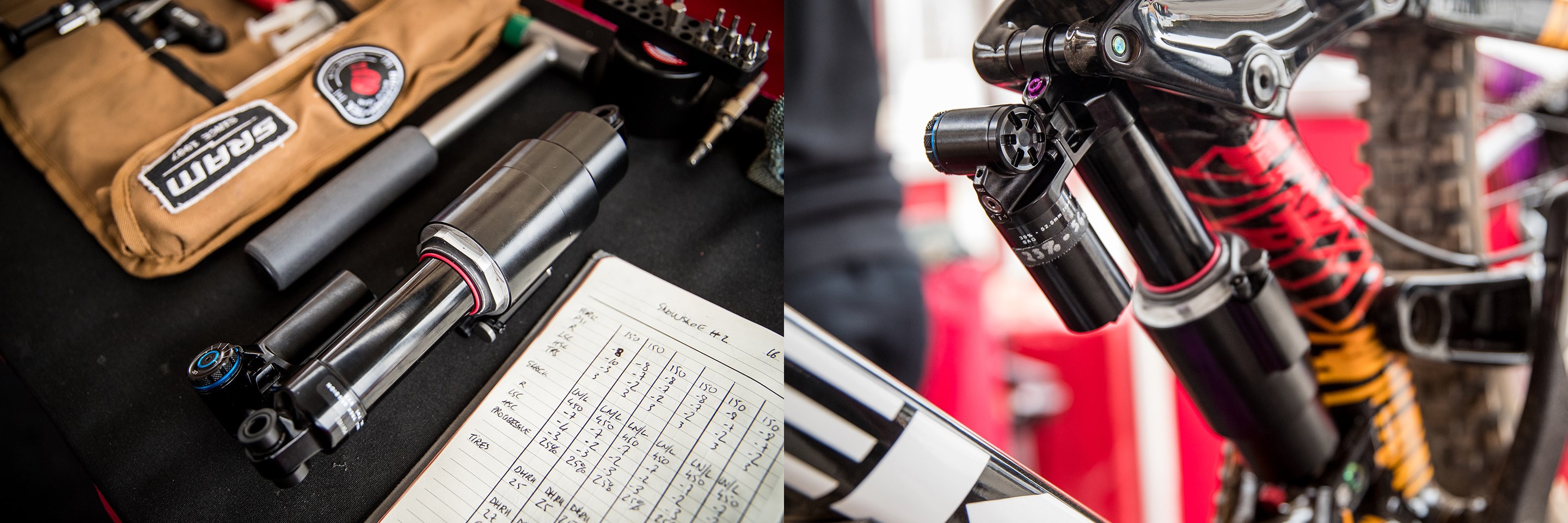
The testing event at Snowshoe proved to the development team that they were onto something with Vivid, but they wanted to focus in on developing damping characteristics for downhill applications in an air shock. The athletes preferred how sensitive coil shocks are to movement at the top of travel, but they wanted the mid-stroke support and ending ramp that the air spring delivers. So, the development team took the best parts of a coil shock paired with the best parts of an air shock, tuned the damper to complement the air spring, and made the new Vivid.
Does bigger = better?
Not always (looking at you, BoXXer), but in Vivid’s case, bigger is a better fit for burlier, harder-hitting bikes and riders. Before we dive into technologies, let’s take a surface-level look at what sets Vivid apart.
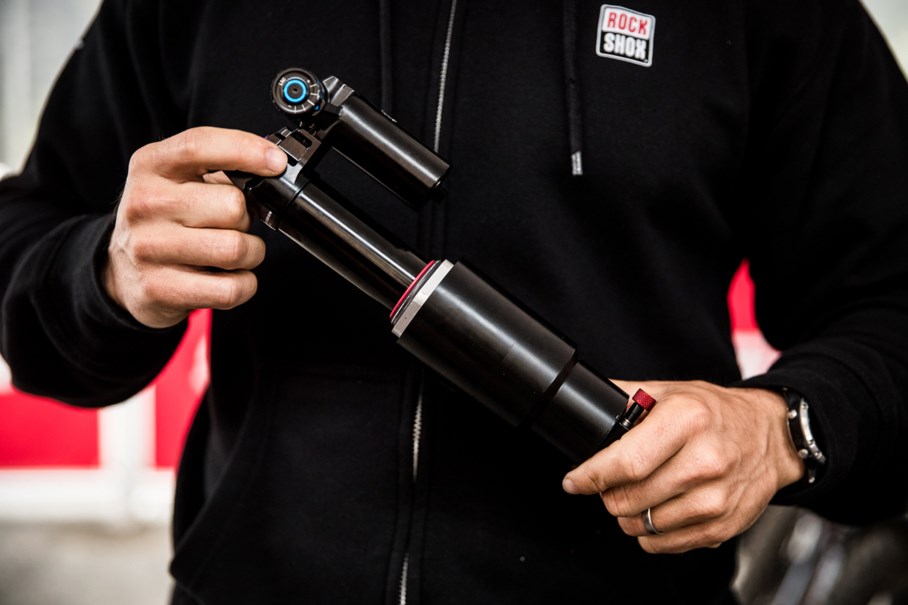
At first glance, it’s evident that Vivid is bigger and more robust than our other air shocks, and that’s on purpose. The development team started with Super Deluxe Coil’s chassis orientation, with the reservoir positioned next to the damper body instead of next to the air can. This gives the damper oil a more direct path to flow through the damper—as the shock compresses, the piston pushes the oil up and out of the damper body, through the neck, and into the reservoir. Compared with our Super Deluxe rear shock, the oil flows through a shaft first before making it up through the neck and into the reservoir. [Check out the animations within the Hydraulic Bottom Out article to see the difference between Super Deluxe’s and Super Deluxe Coil’s internals.] To be clear, neither is better than the other; they utilize different applications to create or reduce damping for specific rider use cases. Because Vivid focuses on descending performance, its larger surface area and increased oil volume help dissipate damping and air spring heat from from those fast and hard hits, which helps keep the shock feeling smooth and consistent for the whole run.
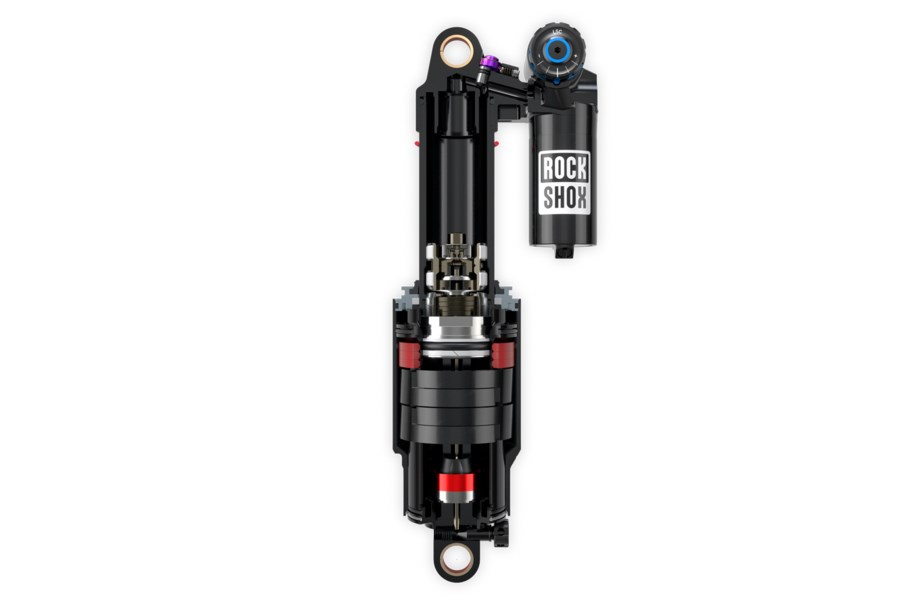
With a bigger chassis comes a bigger air can. To maximize the volume of the air spring, they added an outer air sleeve to create more positive volume between the air can and the outer air sleeve, which bumped out the air can (more on that later).
Those are Vivid's external updates, but what’s going on inside? Let’s dive into Vivid’s new TouchDown RC2T damper and our most coil-like air spring ever.
TouchDown RC2T Damping
Vivid’s new damping technology is based on the idea that riders have different damping needs based on where in the stroke they are and what speed the shaft is moving, so the development team broke that down into three different phases of travel. The first 10% of travel is the beginning stroke—when you want the rear shock to feel supple and free on small bumps to maintain traction. The transition to the middle of the stroke—from 10% up to 80% of travel—is where shaft speeds ramp up and when riders need to feel supported and in control without harshness or feeling like the shock is wallowing. And then the end of the stroke—the last 20% of travel—is where you want the shock to feel bottomless and comfortable even on the hardest of hits.
To make the initial touchdown (see what we did there?) softer and more sensitive to movement as the wheels return to earth, the team decreased compression damping in the first 10% of travel. As the piston moves through the damper body at the start of a compression event, the oil contained within the damper body flows freely through the piston and out past the reed valves, thanks to a recession/cutout in the damper body walls. Oil flowing freely with minimal resistance reduces damping for a softer initial feel and better traction.
As the piston moves past the TouchDown circuit and into the main compression circuit, it moves up past the recessed wall of the damper body, where the main wear band seals against the inside of the damper body. This forces the oil to go through the piston to push past the shim stack, slowing the oil flow to create more damping. Because the shaft speeds start to increase as we enter the main 70% of travel, the increased damping provides more support through quick hits and technical terrain, making sure the shock doesn’t blow through all the travel.
When the piston reaches the last 20% of travel, it enters the Adjustable Hydraulic Bottom Out (AHBO) circuit, where it pushes the oil through the Hydraulic Bottom Out port, the size of which changes based on where the AHBO adjuster is set. When the adjuster is all the way closed, it increases the pressure building in the AHBO chamber to create more damping and make it harder to bottom out as the shock moves through the stroke. If the adjuster is all the way open, there is no additional bottom-out support, so it’s easier to reach full travel. For a more thorough look at the Hydraulic Bottom Out design, check out Rear Shock Hydraulic Bottom Out.
The chart below shows the initial stroke of a 2024 Vivid with the TouchDown damper (red lines) and a 2024 Vivid, same tune/same shock with a standard damper (black lines). In the first 10% of travel, both at medium shaft speeds (upper lines) and slower shaft speeds (lower lines), Vivid's TouchDown damper has a decrease in compression damping, meaning that it requires less force to initiate travel for both shaft speeds in comparison with the standard damper. Then, there's a smooth transition as the piston moves into the main compression circuit and utilizes the shim stack. An important takeaway from this chart is that the transition from the TouchDown circuit to the main compression circuit is seamless—there is no effect on the rest of the stroke.
Of course, we’d be remiss if we didn’t mention that Vivid Ultimate’s TouchDown RC2T damper offers the same tunability from the 2023 Super Deluxe Ultimate and Super Deluxe Coil Ultimate rear shocks. In case you missed it, RC2T is an acronym: R for Rebound, C for Compression, 2 for the number of Compression Adjustments—High Speed Compression (HSC) and Low Speed Compression (LSC), and T for Threshold. With RC2T, HSC and LSC have completely independent adjustments, so setting HSC has no effect on LSC—and vice versa—meaning you have absolute control over how your rear shock feels for exactly how you like to ride. Learn more about how independent HSC and LSC work in the Rear Shock RC2T Damper article.
Vivid's Air Spring
What makes Vivid stand out from a coil shock is the air spring. Kind of like, “duh,” but also, it’s worth mentioning that each type of rear shock has its time, place, and terrain… but so much of it comes down to rider preference. Coil shocks are known for their linear spring curve—riders like their consistent and predictable feeling no matter where you are in travel. Air spring shocks naturally have a more progressive spring curve—riders can capitalize on the increasing ramp-up of the air spring rate as the shock moves through the stroke. Coils are heavier—it's a metal spring, after all—and lack the ability to fine-tune the spring without replacing it for another rate. This is where air springs shine: they are lighter and infinitely tunable by setting air pressure and adding Bottomless Tokens.
When designing Vivid, the development team knew they wanted the air spring to be as linear and coil-like as possible but still easy to tune, including adding or removing Bottomless Tokens (without any special tools this time). Because Vivid is larger overall than our other air shocks, its air chambers are also bigger—the addition of Vivid’s air sleeve makes the positive chamber massive—giving the team more room to make the air spring more linear.
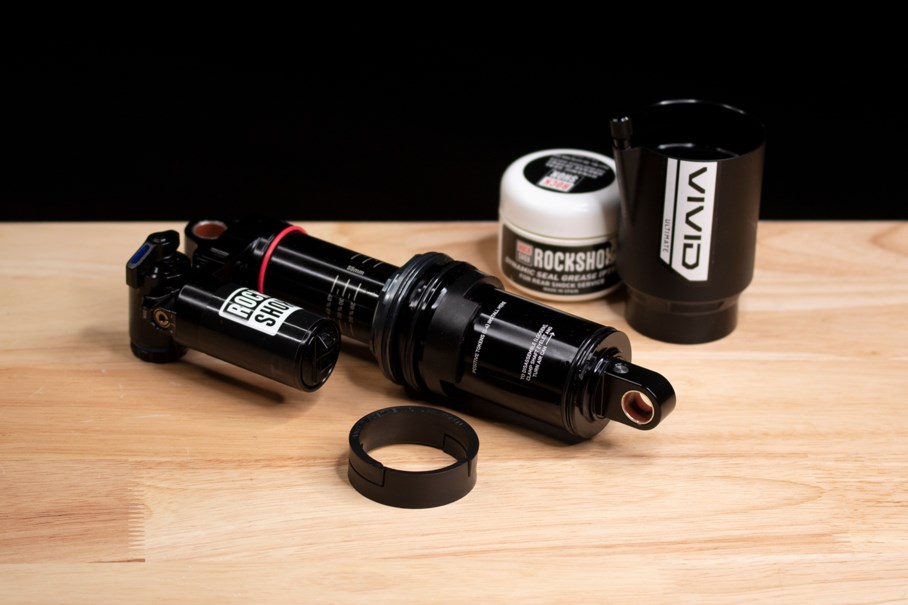
The team updated the air spring to include an inner air can with a surrounding air sleeve. The air sleeve adds positive residual volume, which communicates with the inner air can's positive volume through ports. This additional positive volume allowed the team to lower the compression ratio for a more linear air spring. What is a compression ratio? It’s the shock's topped-out positive volume divided by the bottomed-out positive volume—a lower compression ratio means that the air spring doesn't ramp up as much at the end of travel. Basically, a larger air spring means more volume with the same amount of pressure (as a smaller-volume air spring), so the air molecules in Vivid get less squeezed during compression, reducing the air spring's ramp as it moves through the stroke and making it more linear.
These updates led us to relocate the dimple that allows the air to swap from the positive to the negative chamber and balance the air spring. It’s now approximately aligned with the damper tube's 35% sag hash mark (compared to Super Deluxe's 15%ish dimple location), which requires a slightly more in-depth pressure equalization process between the positive and negative chambers. For a more thorough setup guide, check out Vivid Air Setup and Tuning.
Ultimately, they created the air spring curve they were looking for: easier to initiate travel for better small bump absorption, a supportive middle stroke, and a comfortable bottom-out resistance near the end of the stroke (which all plays very nicely with the TouchDown damper).
The Verdict
Vivid was designed to charge through anything the world’s toughest tracks can throw at it. No longer do you have to choose between a coil and traditional air shock when it comes to choosing the right tool for the track. With TouchDown technology and its upgraded, bigger air spring, Vivid stays supple and sensitive, composed on big hits and small bumps alike. But don’t take our word for it. We asked 2022 Enduro World Series Champion Jesse Melamed what he thought of Vivid:
I have always felt air shocks lacked the suppleness of coil shocks. With TouchDown technology, I feel Vivid has closed the gap to coil. I have noticed the stability of that small bump sensitivity many times since riding Vivid, enough to make me think ‘wow, that's crazy’ while it's happening.
–Jesse Melamed, Canyon CLLCTV
Questions about required tools for service, Bottomless Token count, or how to know if you've used full travel? Head to the Vivid FAQ page. Let's party!
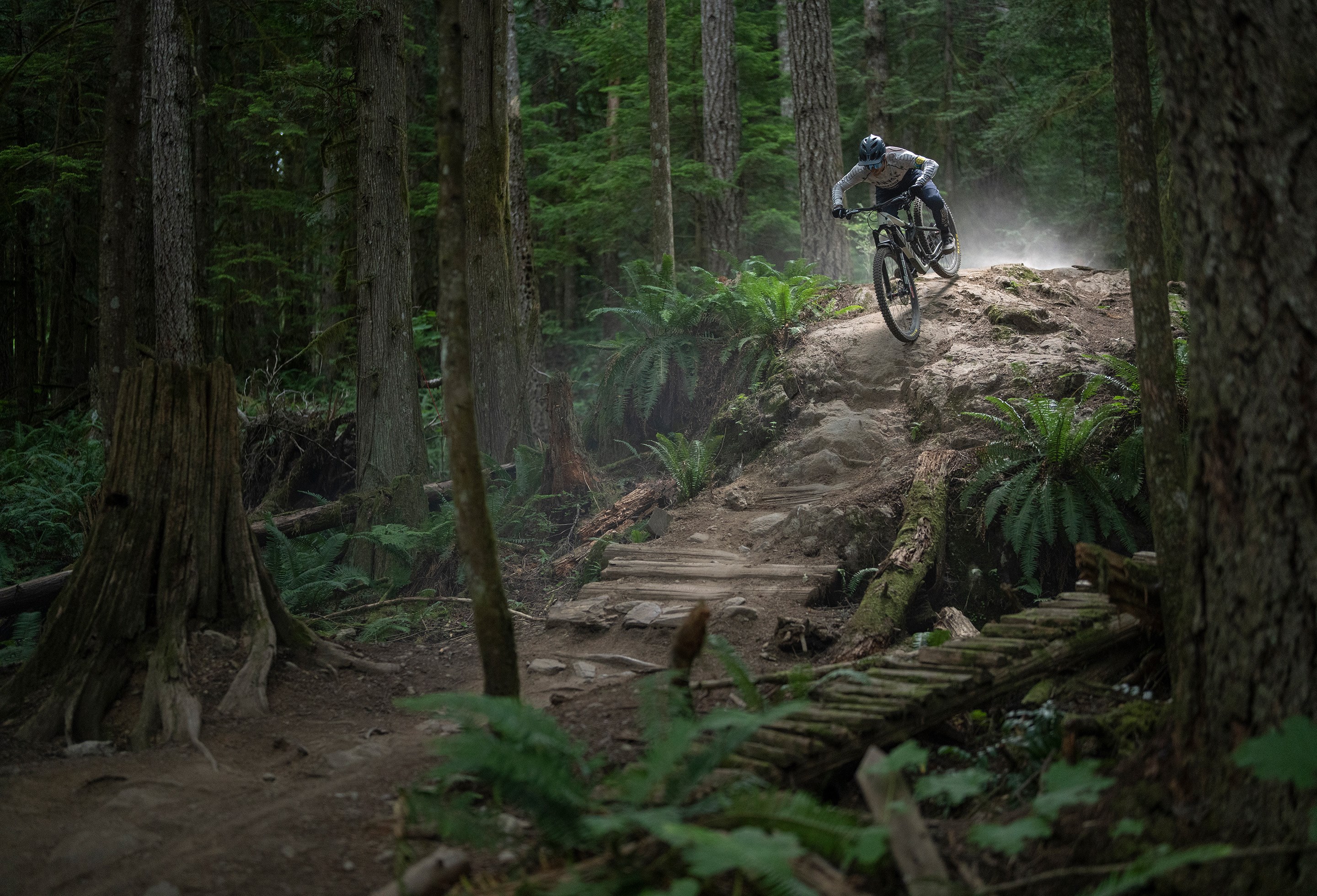
Animations by Ray Bach. Photos by Andy Vathis and Mason Mashon. Words by Sarah Walter.